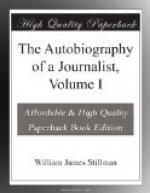The school to which I was sent was one of those founded by the Public School Society, a voluntary association of well-to-do citizens, who, in the absence of any municipal initiative, had organized themselves for the encouragement and support of primary education. As they were originally excluded from the management of the schools, the politicians, finding this a new field of operations and partisan activity, presently established the rival system of the municipal schools called “ward schools.” At that time the political intrigues of the Catholic Church for the control of the public school system had just begun. The Public School Society had been organized for the free and non-sectarian education of all children unable to meet the expense of education in the private schools, and received subsidies from the municipality. Not only were all children under sixteen admitted to these schools without any fees, but the books, stationery, and all other material necessary were furnished gratuitously, and those who were shoeless were even provided with shoes, the only requisites being cleanliness and regular attendance. The direction was rigidly non-sectarian. The trustees were unpaid, and they comprised many of the leading citizens interested in popular education. They had built for their service sixteen schoolhouses in New York, and in each of these there were on an average a thousand children. The schoolhouses, of three stories, had a primary department for such children as were too young to be taught their letters or were not yet able to read and write, and to them the basement was given, the second story to the older




